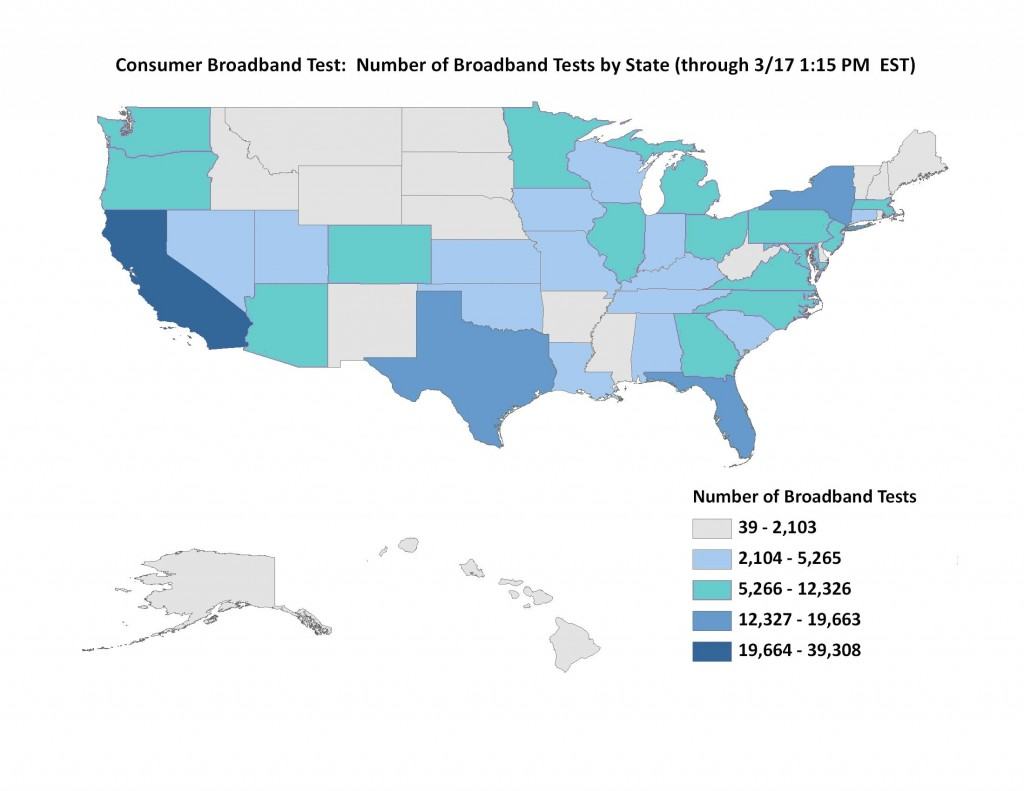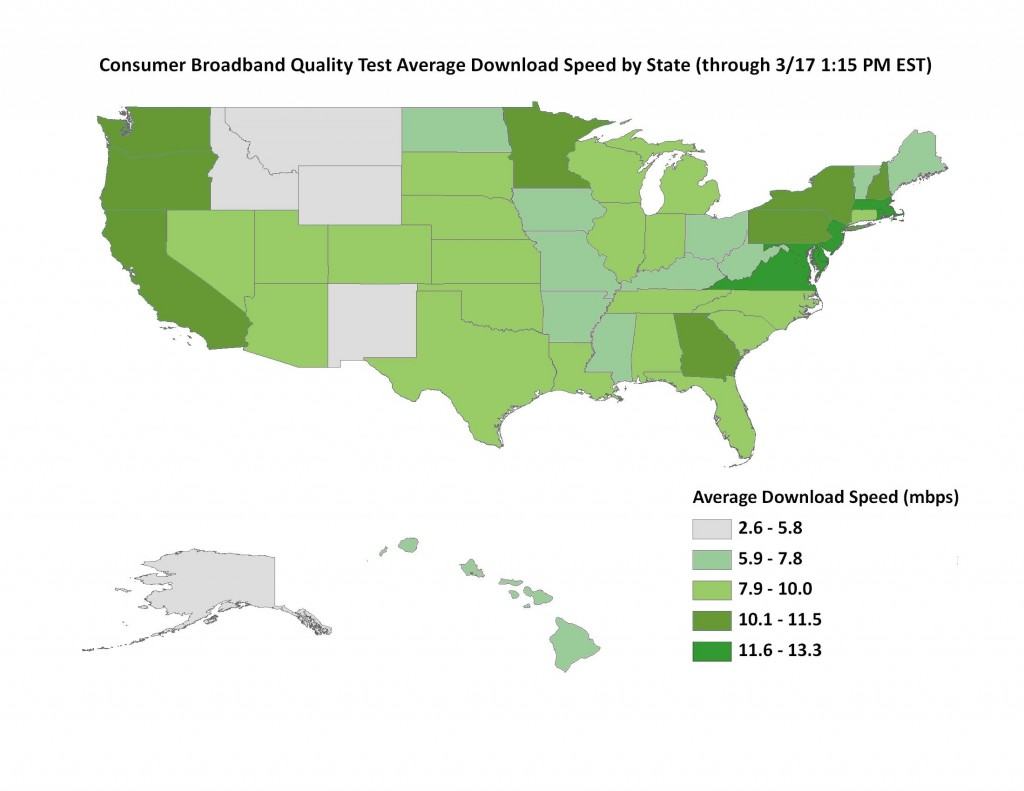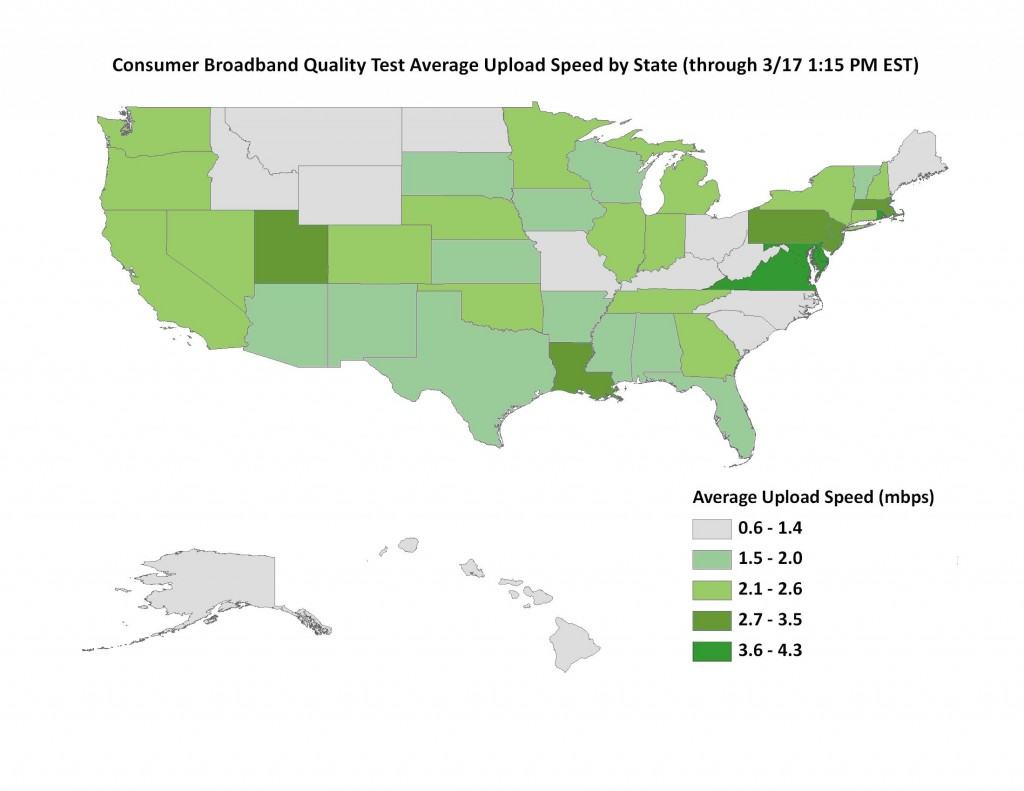 The Federal Communications Commission is catching on to a long-known telecommunications industry secret — always provide top quality, showcase service in areas where the movers and shakers of power and politics can make your life easy or hard. Early results from the Broadband.gov national speed test project confirm this is still the case. After a few weeks of testing, the FCC reports America’s best broadband speeds are available in and near two cities – Washington, DC and New York, NY.
The Federal Communications Commission is catching on to a long-known telecommunications industry secret — always provide top quality, showcase service in areas where the movers and shakers of power and politics can make your life easy or hard. Early results from the Broadband.gov national speed test project confirm this is still the case. After a few weeks of testing, the FCC reports America’s best broadband speeds are available in and near two cities – Washington, DC and New York, NY.
In Virginia and Maryland, where most of DC’s workers-by-day commute home to at night, average download speeds topped out at 11-13Mbps. Upstream speeds were, on average, best in the nation at around 3.6-4.3Mbps. In New York and Massachusetts, where Verizon, Comcast, and Time Warner Cable predominate, average downstream speed was 11.6-13.6Mbps, but upstream speed in the northeast suffered more thanks to upstate New York and western Massachusetts dragging the numbers down.
Several critics have joined Stop the Cap!‘s concern that the two speed tests, provided by Ookla and M-Lab, are providing widely different results. The FCC plans to expand the available speed test options shortly to attempt to get a wider sampling of broadband speeds.
Despite this, Jordan Usdan, an attorney-advisor to the Broadband Task Force, claims the group is happy with the results:
87% of test takers are home users, which is the FCC’s target audience with this application. Additionally, a clear trend is visible across business sizes, high bandwidth connectivity for community institutions, and lower bandwidth for mobile connections. Again, these results are non-scientific extrapolations from the Beta version of the Consumer Broadband test. Additionally, about 98% of user submitted addresses are geo-coding correctly, which is a very good rate.
Thus far, Californians have taken the most speed tests, but their results are less impressive than those enjoyed on the Atlantic seaboard — average downstream speeds in the state are 10.1 to 11.5Mbps; upstream speeds are 2.1 to 2.6Mbps.
Where are the worst speeds? In the Northern Plains states, where rural populations predominate. Idaho, Wyoming, and Montana delivered the worst combined upload/download speed results. But speeds are only marginally better in the midwest and southeast — with lots of low scores in the Carolinas, Tennessee, and Mississippi. Customers in northern New England stuck with FairPoint Communications also have little to celebrate.


 Subscribe
Subscribe


You are just going have to get through your heads rural areas many miles away from anything are not going to be considered. A company can not spend a half million to provide 10 houses spaced miles apart for broadband when maybe half wont pay for the service. If I had stock in the company I would be on the phone with the CEO asking him if he was nuts. It is not going to happen. I want return in a year not 20. The guy above ground signing your time cards is going to make 10 times the amount… Read more »
In those exceptional cases I’d agree, they need to accept that wireless broadband with WiMax is likely the only viable option, however there’s no reason that american towns and cities shouldn’t have the investment made in fibre to wire them just because they aren’t one of a few select metro areas with heavy competition. This is infrastructure that pays back into our economy and is a great benefit for tens of years down the road.
Is it really going to help the economy? I have been think about this for a long now and I don’t see it. A business has a business connection so they are covered but watching TV, playing games, or sending a picture to grandma are not going help anything except triple your service bill. Is that help? Now you get to choose between food, health care, or the internet., etc. Are two farmers miles away emailing about tomorrows rain going going to help? no. If it rains it rains. Ill use Phil as an example. He loads his rented service… Read more »
Uncle Ken –
And we did not need more than 1Mb of RAM right? 🙂 (or whatever the number was…)
The problem is not what we have today, but what we can have in the future. The speed matters as we go forward and new technologies are interoduced. It is not the waiting part, it is the application part.
Uncle Ken, Then by your argument we could all still be on 56k dialup modems saving tons of money only paying our old $15/20/mo for unlimited dialup and be all for the better with no positive effect on the economy or conveniences we enjoy today. I think it’s pretty evident where we are today even with the relatively meager investments into broadband to utilize the internet and various services/apps/ecommerce that we’ve benefited greatly. Our broadband infrastructure is our communication infrastructure for the coming years, every dollar we put into it will be a good investment provided it’s done wisely. Investing… Read more »
I did not say people don’t like broadband I said 200/20 speeds but
to what end?
Who knows to what end? The sky is the limit. It is about applications, not wait time. The bigger the pipe to my house, the more the entire house can make use of that pipe. This is not just about sitting down at a computer.
the house of the future should have a fast broadband connection that is used for any number of things – including your phone service. 1 broadband connection to your hone, anfd all the services that you want through that one connection. But it has to be fast to be able to handle that.
Your debate points are well taken and noted. First Ill address the phone. Yes one could save a few bucks but with real copper I have unlimited connection to talk.( did anybody else here that starting at 12:50 last night TWC went down for about 5 minutes. in Rochester in my area. I can not comment how far reaching the outing was. A house of the future is ripe for running lines while in the framing stage same as electric lines and plumbing. If you could do it both coax and fiber lines so they do not need to tear… Read more »
Well at the moment the primary driver for increased bandwidth needs on our coax and fiber lines is video programming. For high def video to be carried over your line without major compression it needs an extreme amount of bandwidth above what you’re suggesting. We’re also seeing more cloud based services and apps, such as online computer backups which benefit greatly. There’s even interest in distributed computing type services happening again, one company launching in a couple months is looking to break up the gaming console model now by having you subscribe to a monthly service to get a cheap… Read more »
Jason, I agree with your sentiment about fiber projects being municipally-run with open access platforms to all-comers. You’d have to provide substantial tax credits or other benefits to offset the investments Verizon, among others, have already made in their own fiber networks if you don’t want them being the strongest opposition to such projects. I also think it’s fair to compensate them if this country ever takes a “national fibernet” approach to this. I believe this is realistic because the Return on Investment for fiber in many areas will take 10-20 years to realize, far too long for many private… Read more »
The house of today already has multiple devices vying for the bandwidth we have. I have 15/1 The following devices consume bandwidth in my home: 6 computers – 1 server and 5 (1 for each person) computers 3 DirectTV DVRs Vonage phone service 3 Nintendo DSis 2 Xbox 360s 1 Nintendo Wii I would like to get a web based security/survallence system for the outside of my house as well. I have 3 children and all 3 of them could be doing 3 separate things that take bandwidth at any one time. They are not even old enough to have… Read more »
Your debate points are also understood and noted. (do note… video music, and games were off limits in this very nice debate) So right now nobody gains a thing. Im all for the city, town fiber loops. The big problem is who pays for it and how much of a cut those cities and towns want for doing nothing. I think they don’t need a dime… They are not doing any of the work. To get a 200/ 20 connection (a number I just picked out of air) Your looking at $200+ to 300+ a month right now. I don’t… Read more »